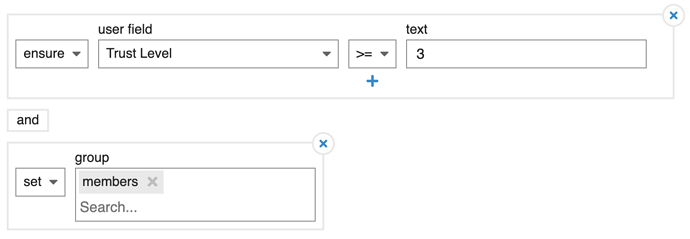Conditional settings behave differently depending on the conditions you give them. You can spot conditional settings by their grey border.
Each condition can have 3 parts
- A type
- A set of key-value pairs (see “Pairs and Connectors” below)
- An output.
Different condition types have different combinations of these parts.
Types
There are four types of conditional fields. For each conditional field, you typically can only select one or two types.
Conditional (“If”)
If the key-value pair match, the “output” is the setting value.
Assignment (“Set”)
Set the setting value directly.
Association (“Map”)
Set the setting value with a list of key-value pairs.
Validation (“Ensure”)
The setting is determined by whether the key value pairs match
Chaining
Conditions
Some conditional fields allow for multiple conditions. In most cases these inputs are alternatives (they are joined by “or”). The conditions are checked in the order they appear (top down).
In a couple of cases the inputs are cumulative (they are joined by “and”), meaning that the setting is determined by whether all conditions pass.
Pairs
You can also chain pairs within a condition. At the moment, the only type of pair chaining you can do is cumulative, i.e. all pairs must pass for the condition to be met and the output applied.
Input Types
There are 8 input types, which appear in different configurations, depending on the setting.
- Text: A text input
- List: A list of text inputs
- Wizard Field: Another field from the wizard
- User Field: A user field of the user using the wizard
- Group: A group or list of groups
- Category: A category or list of categories
- Tag: A tag or list of tags
- User: A user or list of users
Pairs and Connectors
A key value pair is two inputs that are compared or associated using a “connector”. The connector is how the key is compared (or associated) with the value. Not all connectors are available for all condition types, but here is the full list:
- = (equal). The key must match the value exactly.
- > (greater than). The value is cast to an integer if the key is an integer.
- < (less than). The value is cast to an integer if the key is an integer.
- >= (greater or equal). The value is cast to an integer if the key is an integer.
- <= (less or equal). The value is cast to an integer if the key is an integer.
- =~ (regex match). The value is treated as a regex input (ruby based).
- → (association). Used for association inputs (see above).
- is (comparison). This supports these values:
true. Checks if key is truefalse. Checks if key is falsepresent. Checks if key is present (i.e. not empty)







